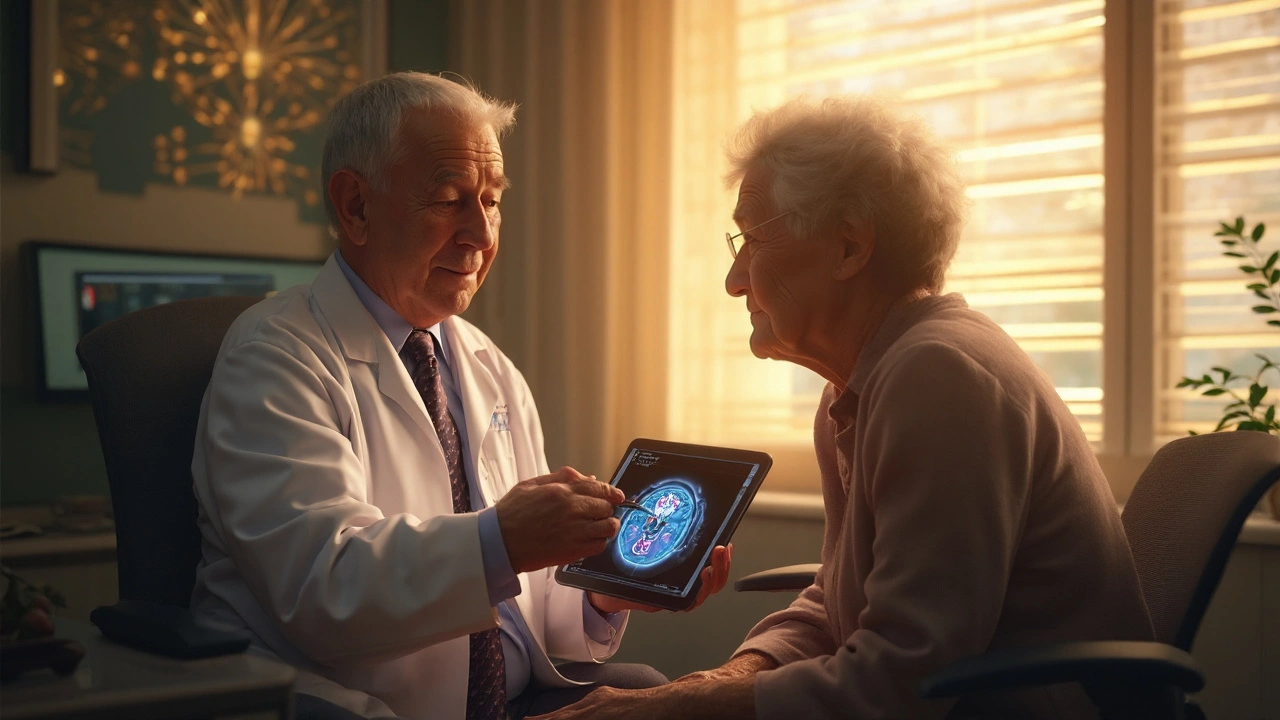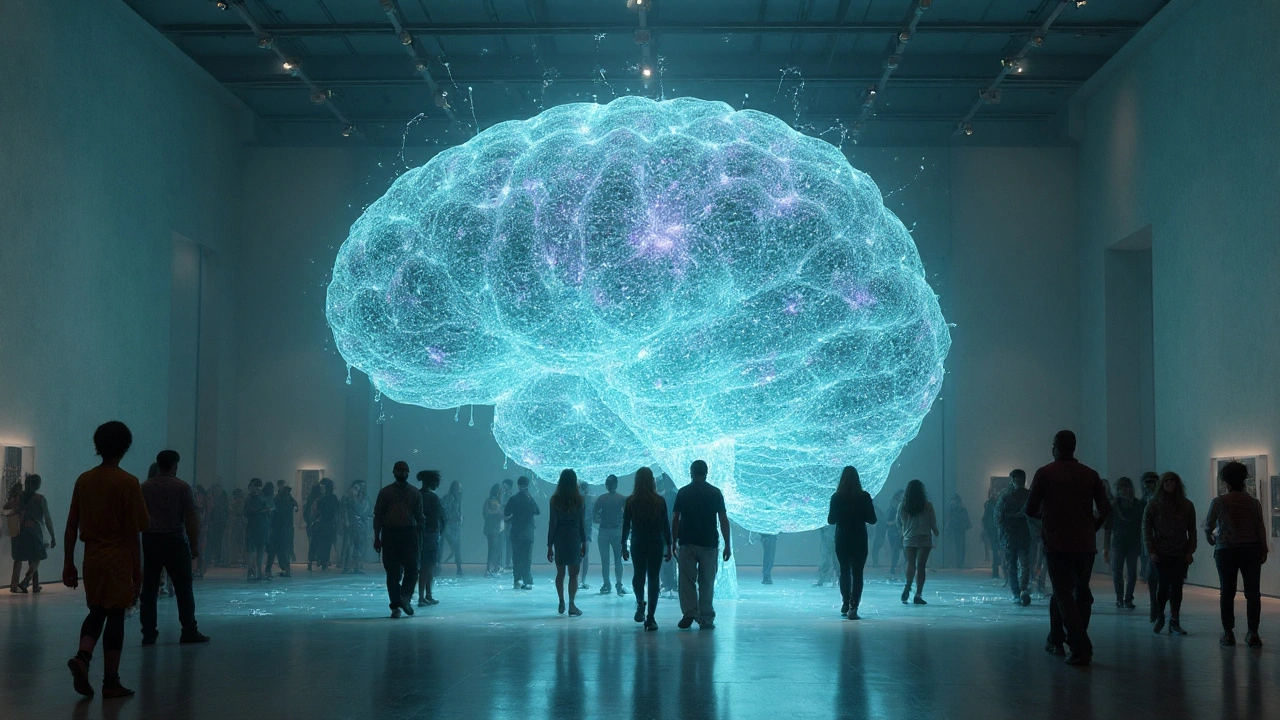Parkinsonism is a clinical syndrome marked by bradykinesia, rigidity, resting tremor and postural instability. It isn’t a single disease; rather, it groups together several neurodegenerative conditions that affect the basal ganglia and dopamine pathways.
Why the Boundaries Blur
Patients often arrive with a set of motor signs that fit the textbook picture of Parkinson’s disease, yet later develop features that point elsewhere-cognitive decline, autonomic failure, or eye‑movement abnormalities. This overlap makes it hard to pin down a single label early on.
Key Players Sharing the Parkinsonism Label
The most common entities that sit under the Parkinsonism umbrella include:
- Parkinson's disease - the idiopathic form, driven largely by loss of dopaminergic neurons in the substantia nigra.
- Lewy body disease - characterized by abnormal alpha‑synuclein aggregates (Lewy bodies) in cortex and brainstem, often presenting with visual hallucinations and fluctuating cognition.
- Multiple system atrophy (MSA) - a rapidly progressive disorder with autonomic failure, cerebellar signs, and a glial cytoplasmic inclusion pathology.
- Progressive supranuclear palsy (PSP) - marked by early postural instability, vertical gaze palsy, and tau‑positive neuronal inclusions.
- Corticobasal degeneration (CBD) - asymmetric rigidity, apraxia, and cortical sensory loss, linked to tau pathology.
Shared Pathophysiology
Even though each disorder has a distinct hallmark, several biological threads tie them together:
- Alpha‑synuclein aggregation: Besides Lewy body disease, alpha‑synuclein deposits appear in Parkinson's disease and in a subset of MSA cases, suggesting a common protein‑misfolding route.
- Dopamine deficiency: All five entities reduce dopaminergic signaling, either by neuron loss (Parkinson’s, Lewy body disease) or by downstream pathway disruption (PSP, CBD).
- Neuroinflammation: Microglial activation is observed across Parkinsonism spectra, hinting at an immune contribution that could amplify degeneration.
- Genetic overlap: Mutations in LRRK2 and SNCA raise risk for both Parkinson’s disease and Lewy body disease, while MAPT variants influence PSP and CBD risk.
Clinical Cross‑Talk
Clinicians rely on a pattern of motor and non‑motor signs to tease apart each condition. Below is a quick “who‑does‑what” cheat sheet:
- Early severe autonomic failure (urinary urgency, orthostatic hypotension) → think MSA.
- Vertical gaze palsy or frequent falls within the first two years → suspect PSP.
- Asymmetric limb apraxia, alien limb phenomenon → CBD.
- Fluctuating cognition with vivid visual hallucinations → Lewy body disease.
- Gradual response to levodopa, resting tremor, and slower progression → classic Parkinson's disease.
Diagnostic Toolbox
Brain imaging, CSF biomarkers, and genetic panels are increasingly used to sharpen the differential:
- MRI
- MSA shows a “hot cross bun” sign in the pons; PSP shows midbrain atrophy (the "hummingbird" sign); CBD may reveal asymmetrical cortical thinning.
- DaT‑SPECT
- Reduced dopamine transporter uptake is common to all, but the pattern helps minor distinctions.
- CSF alpha‑synuclein
- Elevated in Lewy body disease, low in MSA, though assays are still experimental.
- Genetic testing
- LRRK2 G2019S indicates higher Parkinson’s disease probability; MAPT haplotype points to PSP/CBD risk.

Management Implications of Overlapping Diagnoses
Because the core issue is dopamine loss, all patients receive levodopa or dopamine agonists initially. However, the response patterns differ:
- MSA and PSP often show poor or short‑lived levodopa response, prompting earlier focus on symptomatic autonomic care.
- Lewy body disease patients need careful antipsychotic selection; many dopamine‑blocking agents worsen motor symptoms.
- Cognitive decline in Lewy body disease or CBD may require cholinesterase inhibitors, whereas pure Parkinson’s disease rarely needs them.
Related Concepts That Expand the Picture
Understanding Parkinsonism in context also means recognizing adjacent topics:
- Neuroinflammation - cytokine spikes observed in post‑mortem brains, trialed as therapeutic targets.
- Alpha‑synuclein - the protein that misfolds, forming Lewy bodies and glial inclusions.
- Basal ganglia - the deep brain hub that orchestrates movement; its circuitry is disrupted across Parkinsonism.
- Dopamine - the neurotransmitter whose depletion drives the motor phenotype.
- Neurodegeneration - the broader process of progressive neuron loss common to all listed disorders.
Comparison of Major Parkinsonian Syndromes
| Entity | Primary Pathology | Distinct Clinical Hallmark | Typical Levodopa Response | Diagnostic Imaging Cue |
|---|---|---|---|---|
| Parkinson's disease | Loss of nigral dopaminergic neurons | Resting tremor, slow onset | Good, sustained | Reduced DaT uptake, normal MRI |
| Multiple system atrophy | Glial cytoplasmic α‑synuclein inclusions | Severe autonomic failure | Poor, transient | Hot‑cross‑bun sign on T2 MRI |
| Progressive supranuclear palsy | 4‑repeat tau neurofibrillary tangles | Vertical gaze palsy, early falls | Minimal | Midbrain atrophy (hummingbird sign) |
| Corticobasal degeneration | Asymmetric cortical tau deposits | Apraxia, alien limb | Variable | Asymmetric cortical thinning |
| Lewy body disease | α‑synuclein Lewy bodies in cortex | Fluctuating cognition, visual hallucinations | Often good but may worsen with antipsychotics | Reduced occipital DaT uptake, normal MRI |
Practical Steps for Clinicians and Caregivers
- Document the full motor and non‑motor symptom spectrum at every visit.
- Order targeted MRI sequences when autonomic or gaze abnormalities appear.
- Consider DaT‑SPECT if the diagnosis is unclear after clinical assessment.
- Screen for cognitive fluctuations early; a brief MMSE plus hallucination checklist works well.
- If a genetic mutation is suspected (family history, early onset), refer for LRRK2/SNCA testing.
- Tailor medication: start low‑dose levodopa, watch for dyskinesia, and avoid dopamine‑blocking antipsychotics in suspected Lewy body disease.
- Engage multidisciplinary teams-physiotherapy for balance, speech therapy for dysphagia, and autonomic specialists for blood pressure management.
Where to Go Next
The Parkinsonism topic sits within a larger neurodegenerative disease cluster. Readers wanting to dive deeper can explore:
- Mechanisms of protein aggregation in Alzheimer’s disease.
- Recent clinical trials targeting alpha‑synuclein spread.
- Lifestyle factors that modify neuroinflammation risk.
Each of these sub‑topics builds on the shared pathways highlighted above, offering a roadmap for research or personal learning.

Frequently Asked Questions
What exactly is Parkinsonism?
Parkinsonism is a syndrome of movement problems-slowness, stiffness, tremor, and balance loss-that can be caused by several distinct brain disorders.
How can I tell Parkinson’s disease from other Parkinsonian disorders?
Key clues are the speed of progression, the presence of autonomic failure (MSA), vertical gaze palsy (PSP), or marked cognitive fluctuations with hallucinations (Lewy body disease). Imaging and response to levodopa also help differentiate them.
Do genetics play a role in Parkinsonism?
Yes. Mutations in LRRK2, SNCA, and MAPT increase susceptibility to several Parkinsonism‑related disorders, and family history should prompt genetic counseling.
Can lifestyle changes impact the course of Parkinsonism?
Regular aerobic exercise, a Mediterranean‑style diet, and avoidance of neurotoxic exposures have been linked to slower progression in many neurodegenerative diseases, including Parkinson’s disease.
What are the newest treatment approaches targeting the underlying disease?
Clinical trials are testing immunotherapies against alpha‑synuclein, LRRK2 kinase inhibitors, and gene‑silencing techniques. While still experimental, they aim to halt the protein‑aggregation cascade common to many Parkinsonian syndromes.


The article glosses over the proprietary biases hidden in the cited studies.